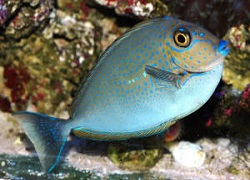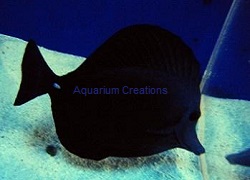Aquarium Conditioned
Vlamingii Tang
Naso vlamingii

Click to view Customers Vlamingii Tang named Elvis
Description:
The Vlamingii Tang or Bignose Unicornfish, is a large member of the Naso species of Tangs which exhibit an elongated body, horse-like face and bulbous protrusion on their forehead giving them the Unicornfish moniker. Juvenile Vlamingii Tang's exhibit a pale green coloration with light blue markings throughout the body, while adults specimens exhibit darker and more varied markings. Adults develop a dark gray body with blue, green, yellow and orange markings around the head and on their finnage. Vlamingi Tang are one of the larger and longer lived Tang species kept within the aquarium hobby, reaching lengths up to 24 inches and living for around 45 years. Their size, lifespan and requirement for large open swimming areas makes this species suitable for more advanced marine aquarium hobbyists with very large aquariums. It is important to note that the Vlamingii Tang is a very fast growing species that reaches it's adult size within the first 5 years of it's life, thus it grows around 5 inches per year. Therefore they should not be introduced to smaller aquariums that cannot provide them the room they need as they quickly grow into their adult form.
Tank Recommendations:
In order to accommodate their large size and quick growth rate as juveniles, the Vlamingii Tang should be house in large aquariums that afford them plenty of open swimming area and rocky formations that they can seek refuge in when they feel threatened. A 180 gallon aquarium 6 feet in length and 2 feet from front to back should be considered the minimum size in which to keep an adult of the species. Keeping adult Vlamingii Tang's in anything smaller in size will likely lead to increased aggression and poorer health conditions as they will become stressed from lack of room and inadequate territory within the aquarium. Like other Tangs and Surgeonfish, the Vlamingii Tang enjoys moderate water currents with areas of stronger water currents and high levels of dissolved oxygen. Some rocks, corals or equivalent aqua-scaping should be provided, but the Vlamingii Tang will spend most of it's time swimming in the upper open areas of the aquarium. Vlamingii Tang are non-aggressive towards tank mates as long as they are provided with adequate room and food, thus they do well in both FOWLR and reef aquariums.
Food and diet:
Vlamingii Tang's are a herbivorous fish species whose diet should mostly consist of marine algae, seaweed and vegetables like romaine or green leaf lettuce. They will also eat meaty foods intended for other fish they share the aquarium with, but the vast majority of their diet should be vegetable based. As is typical of most herbivores, the Vlamingii Tang feeds continuously throughout the day. Therefore, they should be provided with greens or seaweed via a veggie clip or similar setup to allow them to feed on and off throughout the day. In addition to fresh vegetables and seaweed, Vlamingii Tang's should be offered flake, frozen and freeze-dried preparations that contain algae or vegetable matter along with some meaty foods like brine shrimp, mysis shrimp or krill. A diet that is high in vegetable matter will provide the Vlamingii Tang with plenty of Vitamin C and other nutrients that they need to maintain a strong immune systems and avoid becoming susceptible to diseases like lateral line disease. Proper diets also help reduce aggression in fish species as the fish become much less aggressive and territorial when their feeding needs are well cared for.
Level of Care:
Moderate
Acclimaton Time:
3+ hours
Reef Compatibility:
Excellent
Approximate Purchase Size:
Small: 1-1/2" to 2-1/4"; Medium: 2-1/4" to 4-1/4"; Large: 4-1/4" to 6-1/4" XLarge 6-1/4" to 8"
|
Small $89.99
Medium $119.99
Large $239.99
XLarge $359.99
|
|
Aquarium Conditioned
Black Longnose Tang
Zebrasoma rostratum

Click YouTube Video of Black Longnose Tang
Description:
The Black Longnose Tang also called the Black Tang is one of the most impressive and magnificent fish we have seen come through our doors. Nothing else compares to it. Without question, the Black Tang will be a perfect centerpiece for any reef tank and provide the "wow" factor. While similar in shape and appearance to other Zebrasoma Tangs, the Black Tang is distinct with it's extra long nose. Also Black Tang has a jet black appearance only broken up by it's white scalpel. Also below the dorsal fin, the Black Tang can develop a white/silver streak which really looks amazing in contrast to it's all black body. This line will appear as the mood of the fish changes. The Black Tang also boasts a very long lifespan and should be a centerpiece of your aquarium for years. Due to its limited natural range, the Black Longnose Sailfin Tang is rather rare in the trade and quite a bit more expensive than the other Zebrasoma specues. However like all the sailfin tangs it makes a wonderful addition to the aquarium, especially a community aquarium. It is relatively peaceful and will get along with a wide variety of like minded tank mates, but should be the last addition to the aquarium. It must be kept singly as it does not mix with others of the same genus. Bold in nature, it will quickly adapt to aquarium fare and is easy to care for once it is settled. One of the hardiest of the surgeonfish, it is highly disease resistant and responds well to treatment.
Tank Recommendations:
The Black Tang grows to roughly 9 inches in the wild, slightly smaller in the aquarium. Recommended minimum aquarium size is 125 gallons or larger to provide plenty of swimming room. Tangs do have a habit of quarrelling on occassion and we wouldn't want our Black Tang to get in battles with other tangs. For that reason only we suggest it should be the only Tang in the reef or community tank and should be the last fish added to the aquarium. If you insist in having multiple tangs in the tang make sure they are all added at the same time and still make them the last fish added. This will minimize the aggressive nature of the surgeon fish. Remember also, they will do best in a reef aquarium with plenty of live rock and hiding places.
Food and diet:
Black Longnose Tang's are a herbivorous fish species whose diet should mostly consist of marine algae, seaweed and vegetables like romaine or green leaf lettuce. They will also eat meaty foods intended for other fish they share the aquarium with, but the vast majority of their diet should be vegetable based. As is typical of most herbivores, the Black Tang feeds continuously throughout the day. Therefore, they should be provided with greens or seaweed via a veggie clip or similar setup to allow them to feed on and off throughout the day. In addition to fresh vegetables and seaweed, Black Tang's should be offered flake, frozen and freeze-dried preparations that contain algae or vegetable matter along with some meaty foods like brine shrimp, mysis shrimp or krill. A diet that is high in vegetable matter will provide the Black Longnose Tang with plenty of Vitamin C and other nutrients that they need to maintain a strong immune systems and avoid becoming susceptible to diseases like lateral line disease. Proper diets also help reduce aggression in fish species as the fish become much less aggressive and territorial when their feeding needs are well cared for.
Level of Care:
Moderate
Acclimaton Time:
2+ hours
Reef Compatibility:
Excellent
Approximate Purchase Size:
Small: 1-1/2" to 2-1/4" Small/Medium: 2-1/4" to 3-1/4" Medium: 3-1/4" to 4-1/4" Medium/Large: 4-1/4" to 5-1/4" Large: 5-1/4" to 6-1/4" XLarge: 6-1/4" to 7-1/4"
|
Small $1399.99
Small/Medium $1399.99
Medium $1399.99
Medium/Large $1399.99
Large $1399.99
XLarge $1399.99
|
|
|


